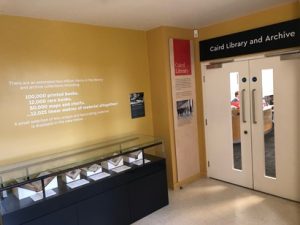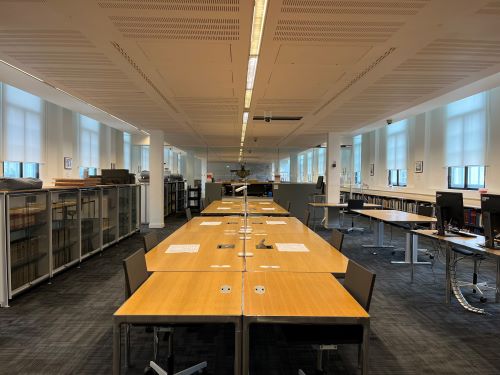We have a new post this month from the wonderful Caird Library and Archive at the National Maritime Museum! Find out more about their history, the collections available and so much more in this brilliant new post written by Shane McMurray, Library Assistant at the Caird Library and Archive:

The National Maritime Museum, together with the Queen’s House, Royal Observatory, and Cutty Sark, forms Royal Museums Greenwich. The Caird Library and Archive serves all four sites.
My name is Shane McMurray, and I joined the Caird Library as a Library Assistant in 2019 (having previously been a volunteer). I provide Reading Room and retrieval services, as well as coordinating the Library and Archive’s blogs, and cataloguing monographs.
History
The National Maritime Museum celebrated its 90th anniversary in 2024 since the National Maritime Museum Act 1934 received Royal Assent from George V on 25 July that year. The Museum was formally opened by his son George VI on 27 April 1937.
Princess – later Queen – Elizabeth was also present that day. Her future husband Prince Philip served as trustee and later Royal Patron of the Museum for many years – the latter role is now held by King Charles III.
The library is named after Sir James Caird of Glenfarquhar (1864-1954), a Scottish shipowner from Glasgow who played a significant role in the founding of the Museum and its national collections.
Acting on behalf of the Society for Nautical Research, of which he was a member, Caird acquired the collection of A.G.H. Macpherson in 1928. James Stanhope, 7th Earl Stanhope and Professor Sir Geoffery Callendar – the other leading figures in the early days of the Museum – were also members.
Presented to the Museum by the Society of Nautical Research, the Macpherson Collection is the founding collection of the National Maritime Museum. It consists of 11,000 maritime prints, rare books, atlases, manuscripts, paintings, and ship models dating from the early sixteenth to the late nineteenth century. Many of these items are now part of the library and archive collections.
In recognition of Caird’s valuable contribution, his bust was commissioned by the Society for Nautical Research and now sits in the Reading Room. Sculpted by William Reid Dick in 1935 it was exhibited at the Royal Academy, though reportedly Caird did not find it particularly flattering. Reid then created a second bust in 1937. This was placed in the Caird Rotunda, where it remains today.
Caird also generously provided funding for the works required to adapt the buildings vacated by the Royal Hospital School into a museum space. His contribution amounted to £74,180 (£5.2m in today’s money) with £4,050 (£292,714 today) of that earmarked for establishing the library.
 Collections
Collections
Since their establishment the library and archive collections have grown to encompass 12 km of shelving with original and published material spanning the fourteenth to twenty-first centuries. In addition to atlases, pamphlets, and printed ephemera there are
- 6 km of manuscripts divided into 852 different collections
- 135,000 books including over 20,000 rare books printed before 1850
- 20,000 bound periodicals with some 200 current titles
- 6,000 books and periodicals on open access
These collections represent the depth and breadth of maritime history, culture, and science across time and space. Diverse topics covered include conflict, migration, colonialism, trade, exploration, navigation, piracy, communication, slavery, astronomy, horology, biography, and maritime art and architecture.
Notable items from the library collections include Edmund Halley’s annotated copy of John Flamsteed’s Historiae coelestis (1712), William Buchan’s Domestic medicine (1779) which was taken from the Bounty by the mutineers, and Ernest Shackleton’s Aurora Australis (1908) – the first book published in Antarctica. It also contains the library of the Royal Observatory, the core of which was built up by Astronomer Royal Sir George Biddell Airy (1801–92).
The manuscript collections are particularly strong in the areas of naval administration, personal diaries and papers, and shipping company records. Collection highlights include:
- P&O business archive, which is on loan to us from P&O
- Lord-Macquitty Collection which includes letters from Titanic survivors
- Michael-Graham Stewart Slavery Collection
Records from the Board of Trade’s Registrar General of Shipping and Seamen also form a substantial part of our archive holdings.
We also subscribe to a range of electronic resources that are free to access in the Reading Room. These include specialist dictionaries, encyclopaedias and indexes, as well as leading family history services and maritime research journals.
Access
For over 80 years the Caird Library and Archive has been facilitating research into every aspect of maritime life and endeavour. Today it is the largest maritime reference library in the world.
In 2011, the Caird Library and Archive relocated from the East Wing of the Museum to its present location within the Sammy Ofer Wing. The old library space has since been transformed into the Pacific Encounters gallery, though it retains some of its original features.
Open Tuesday-Friday 10:00-16:45, we welcome anyone interested in the sea, ships, stars, and time. Visitors can register for either a one-day ticket, permitting access to material in the Reading Room, or a three-year ticket, which will enable access to items from the stores.
To order items visit Collections Online at rmg.co.uk/collections and place requests via our ordering system at rmg.co.uk/aeon/. Both the library and archive collections are searchable via our online catalogues. However, unlike the library collection, the archive collections are not available to search through Library Hub Discover.
Most of the library and archive collections are stored at the Museum in Greenwich. A sizable portion, however, is held at Prince Philip Maritime Collections Centre (PPMCC), our offsite facility in Kidbrooke.
The Reading Room is staffed by a team of professional librarians and archivists, supported by assistants and volunteers. They are available to answer queries from visitors throughout the day. For those who cannot come and see us in person, we can be contacted by email and telephone. A remote digital scanning service is also available.
In addition, we have digitised more in-demand collections in partnership with organisations such as Ancestry, The National Archives, and the University of Cambridge. These include our popular records of Masters and Mates Certificates, Dreadnought Seamen’s Hospital Admissions and Discharges, Second World War Merchant Seamen Deaths, 1915 Crew Lists, and papers connected to the Royal Observatory.
Though not part of the library and archive collections, researchers can access much of the Musem’s extensive holdings of maps, charts, prints, and drawings via the Reading Room. These can be requested by contacting library@rmg.co.uk.
If you would like to learn more about the library and its treasures, you can explore our collections online:
Library: https://www.rmg.co.uk/collections/library
Archive: https://www.rmg.co.uk/collections/archive
By Shane McMurray – Caird Library and Archive
You can explore the library’s collections on Discover and find further contact details on their Discover information page.
All images copyright of National Maritime Museum – Caird Library and Archive reproduced with kind permission of the copyright holder.

